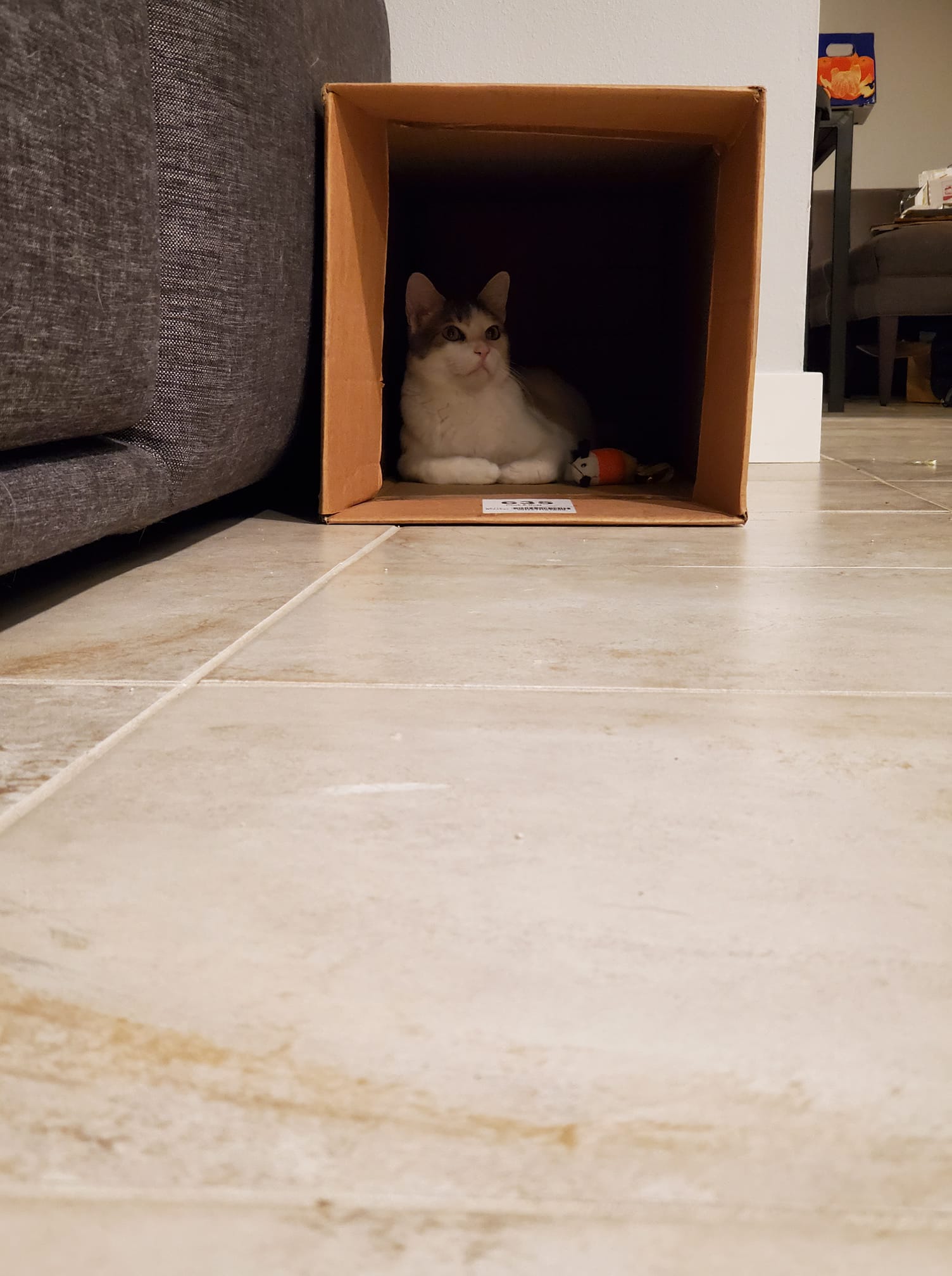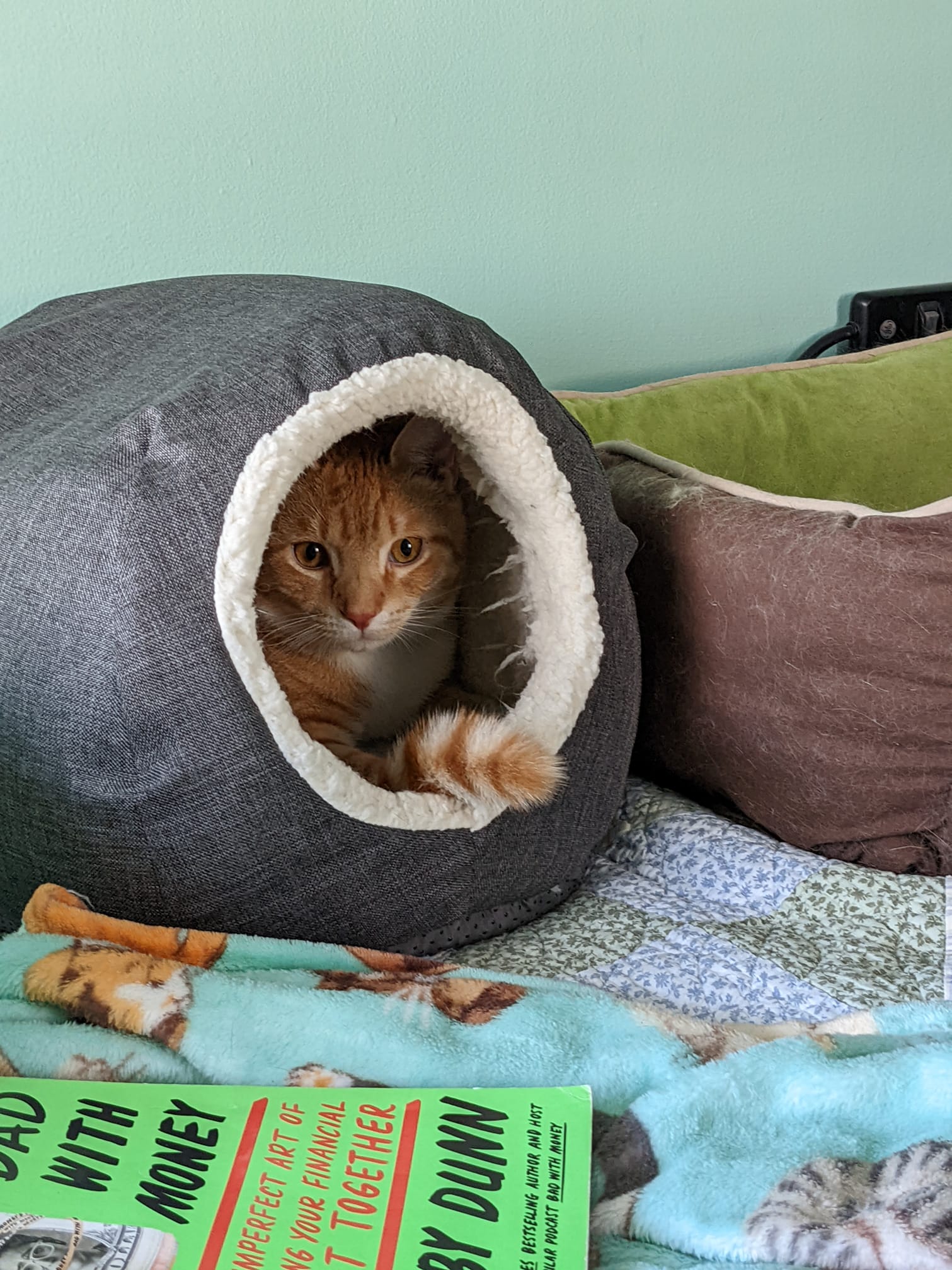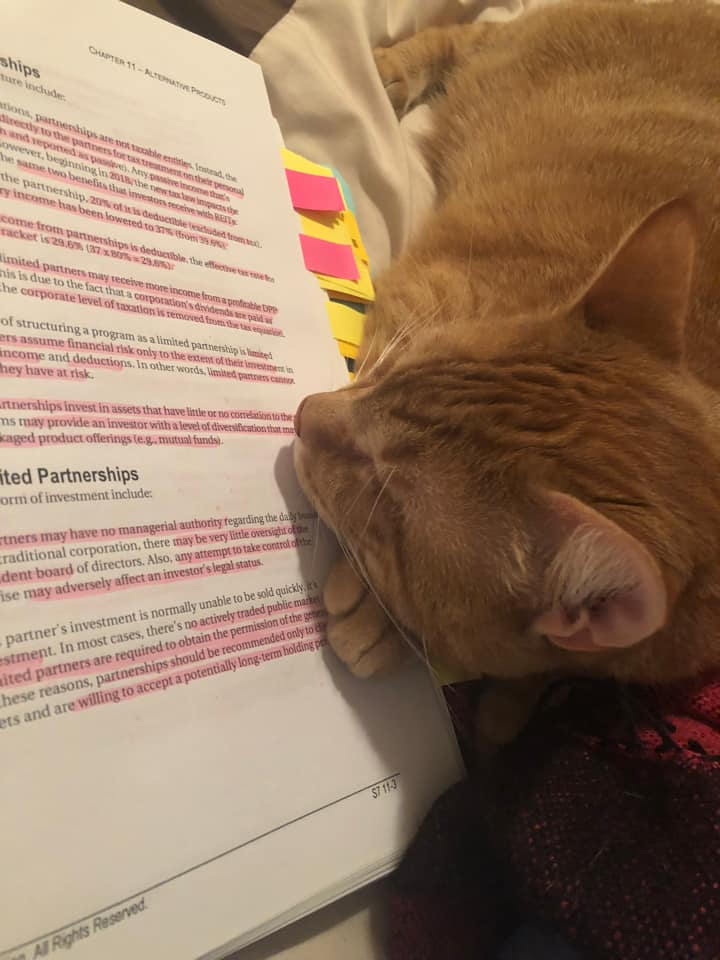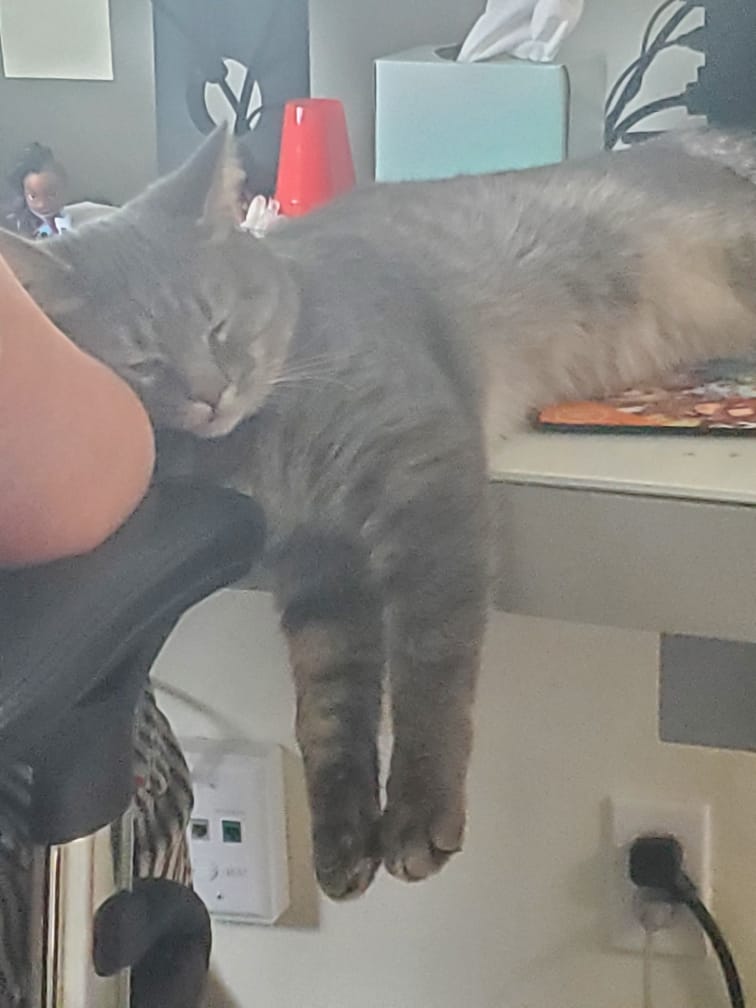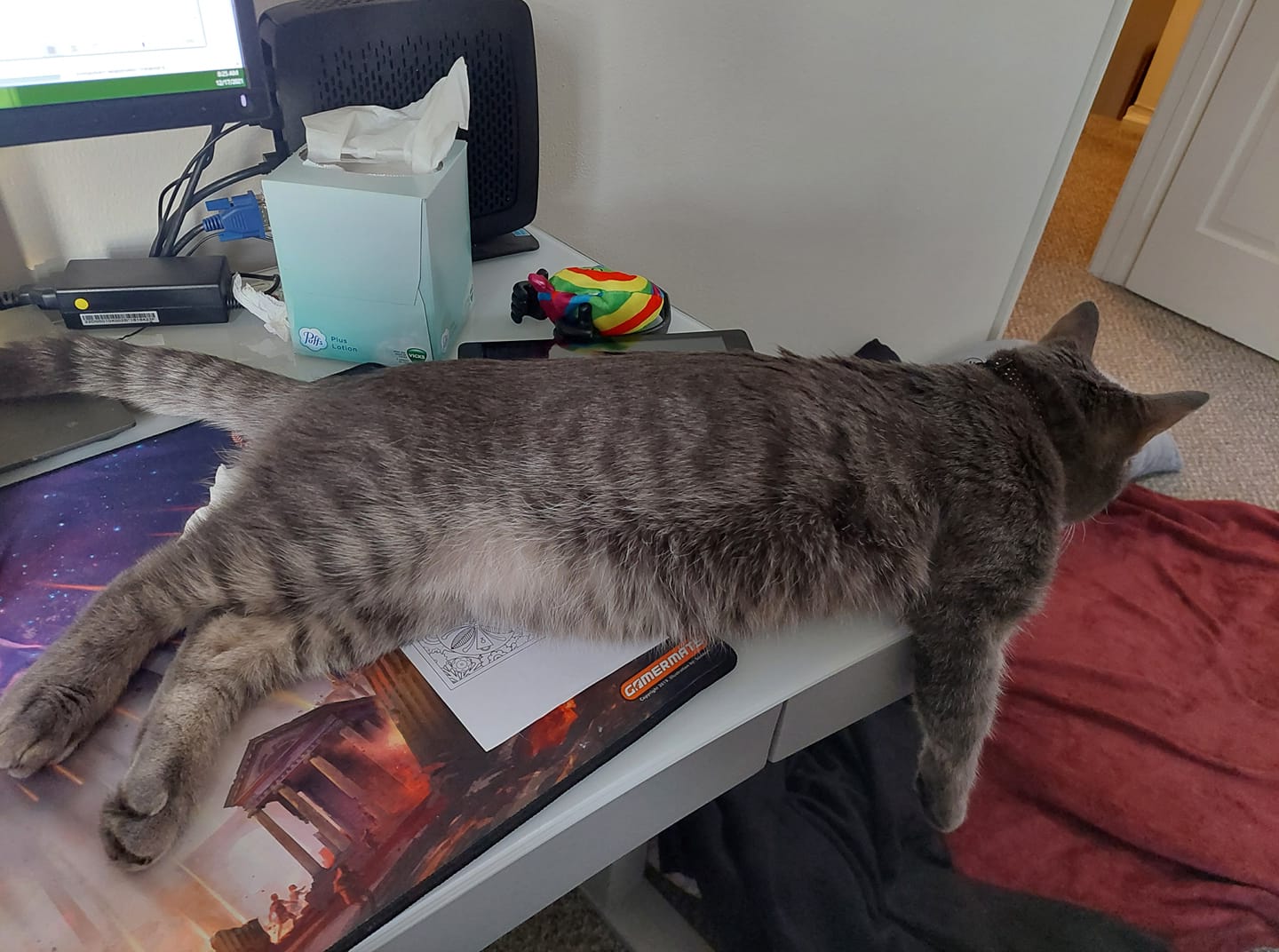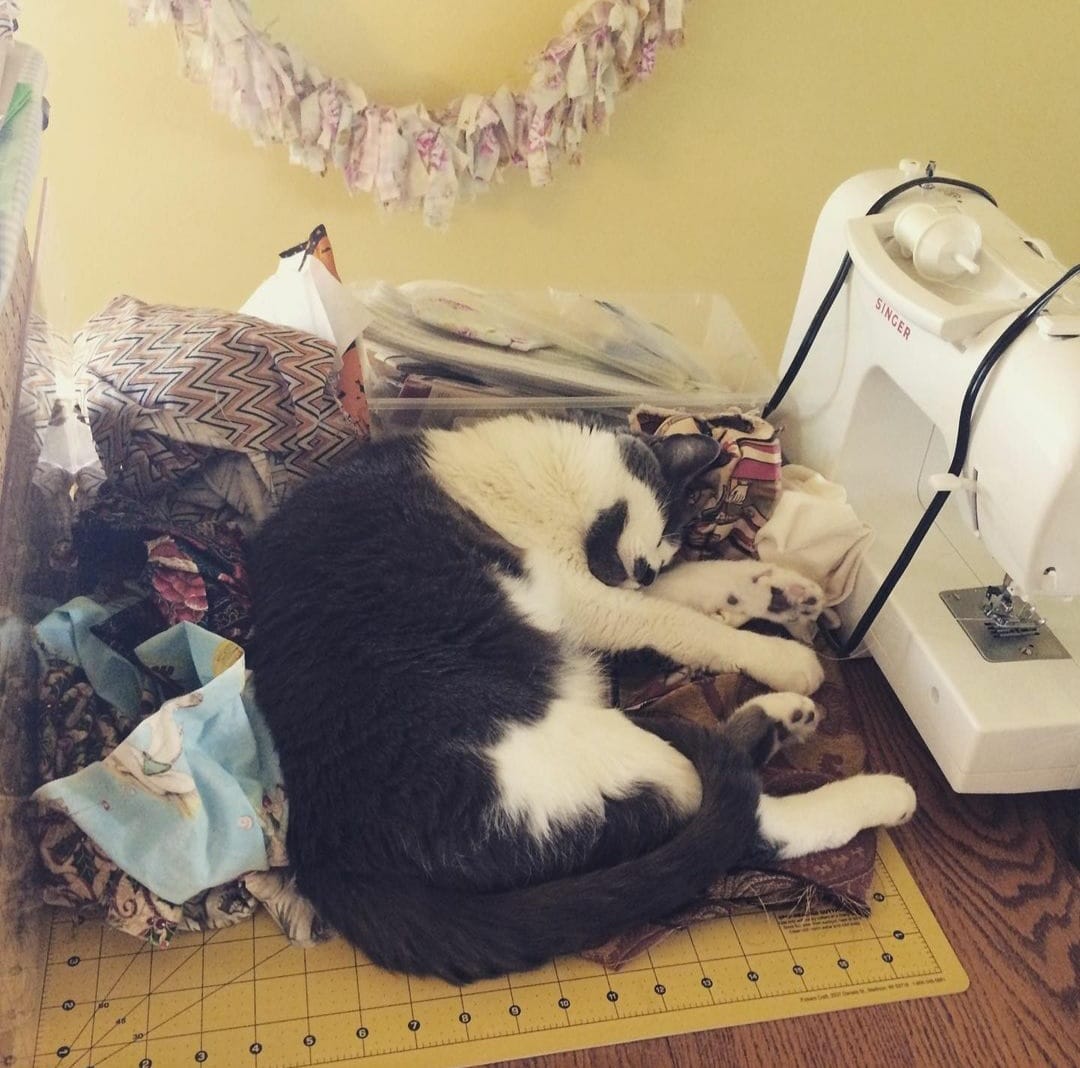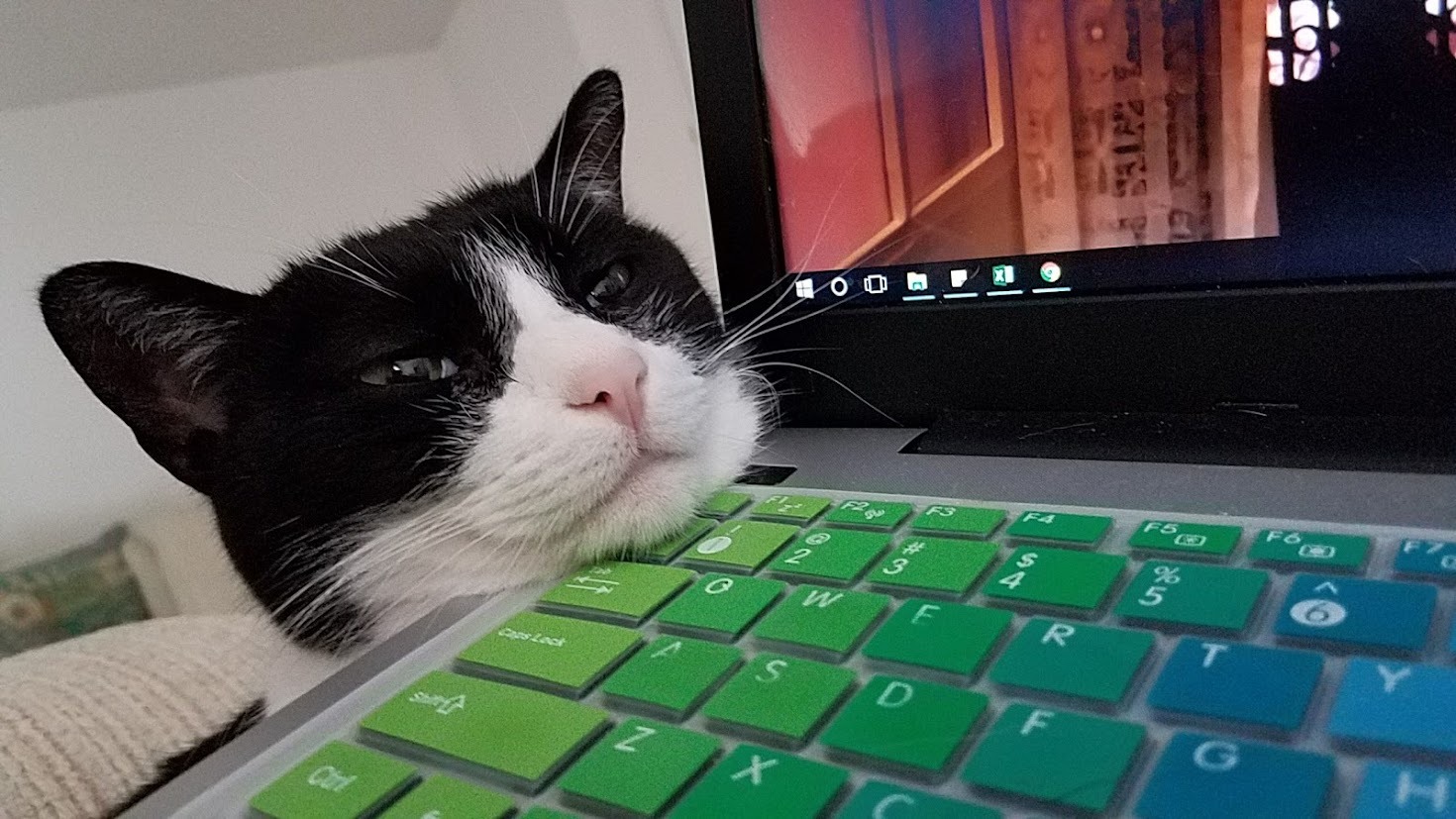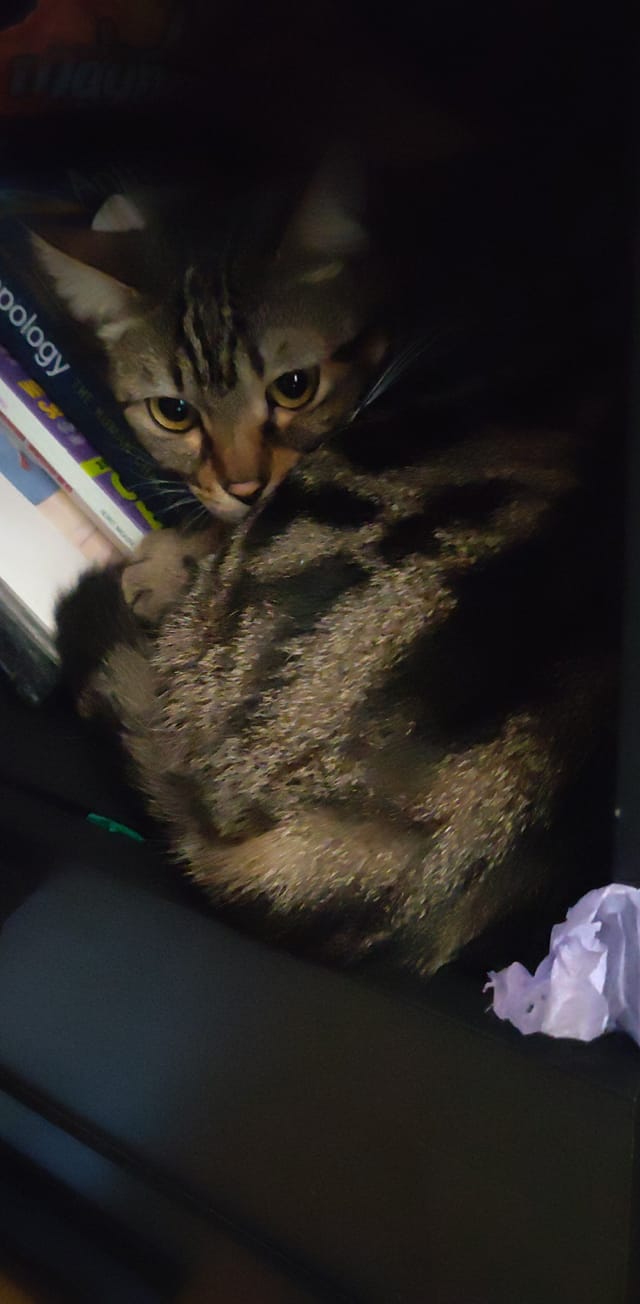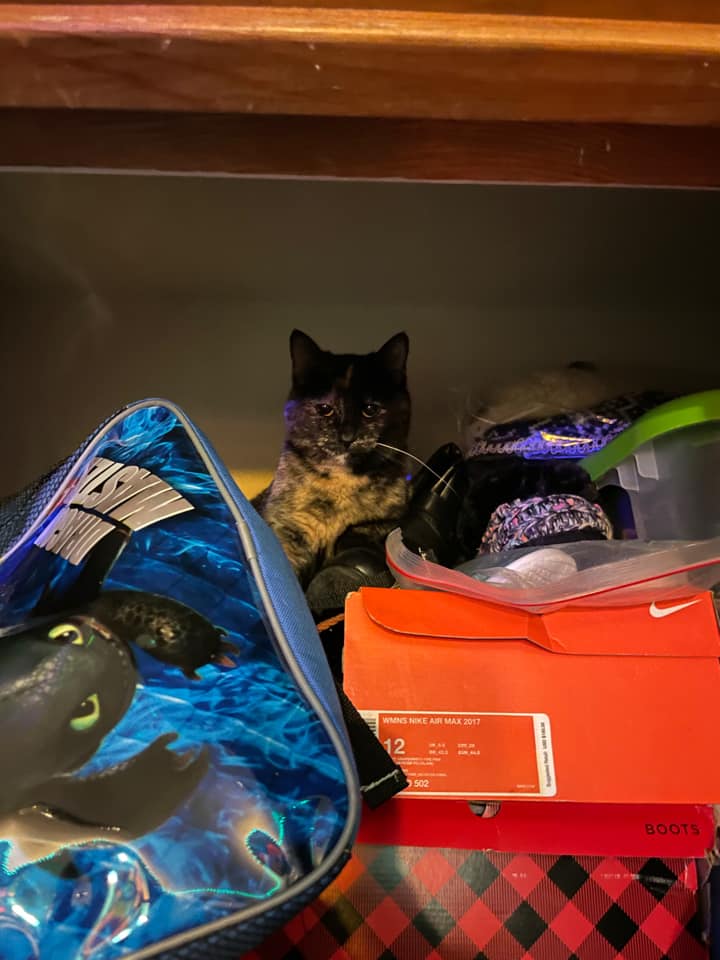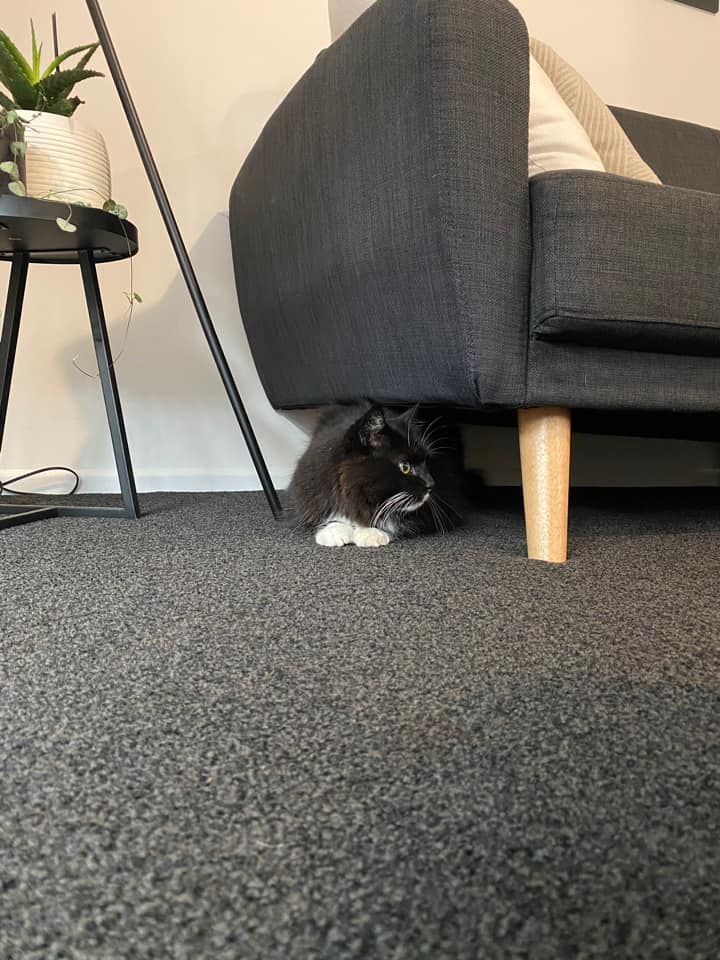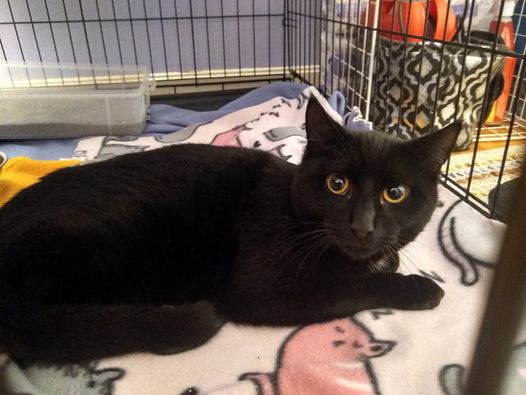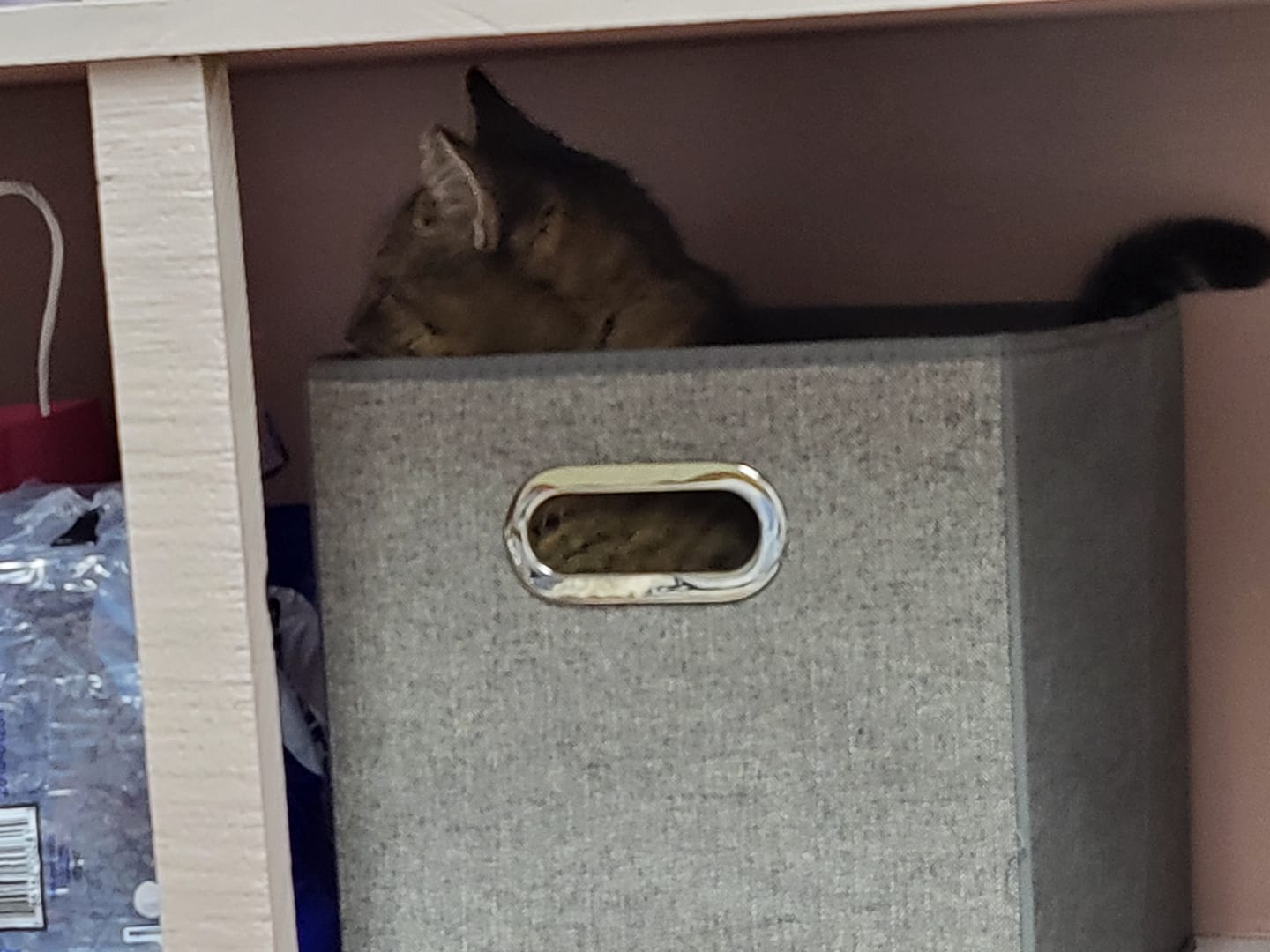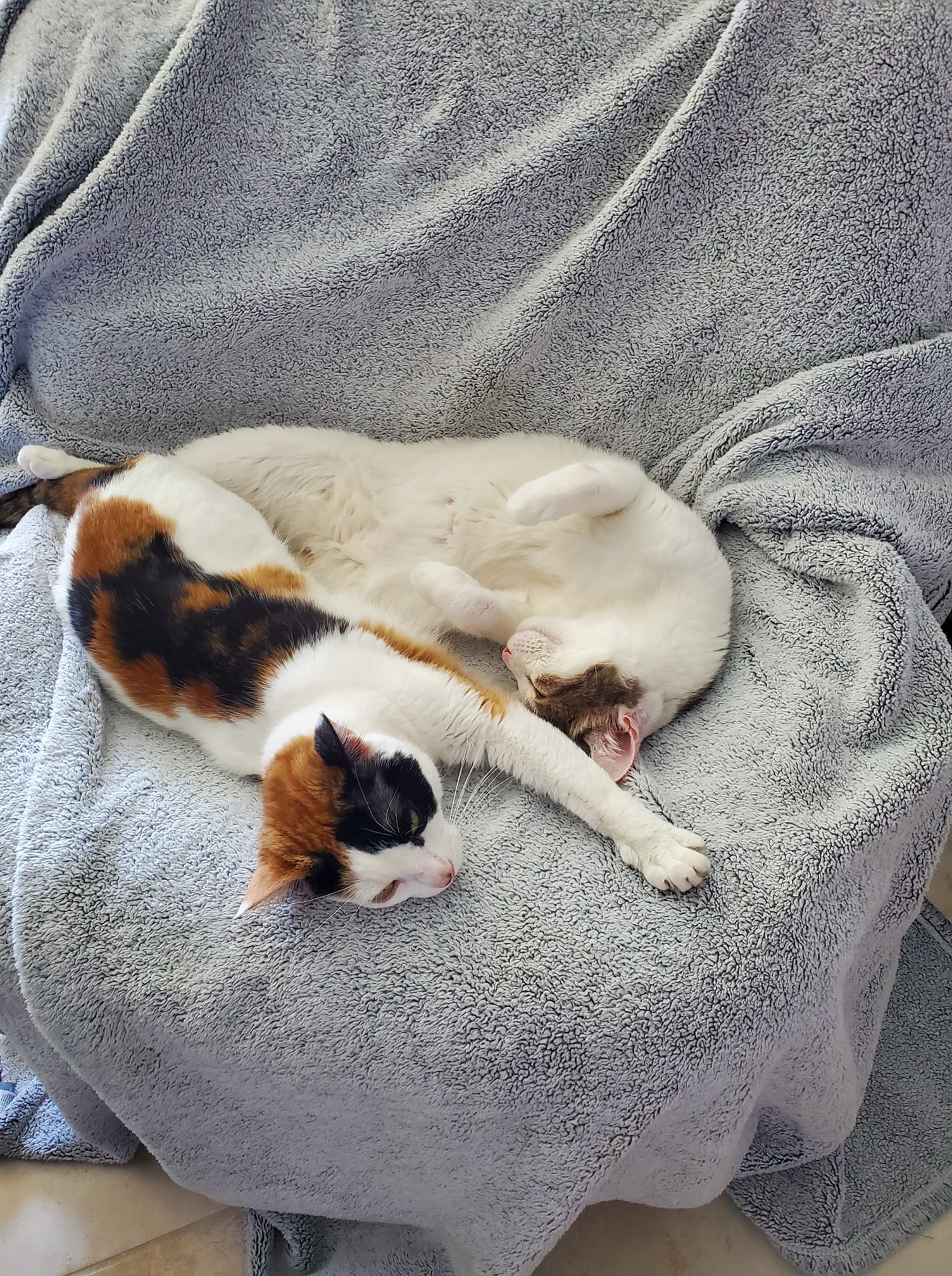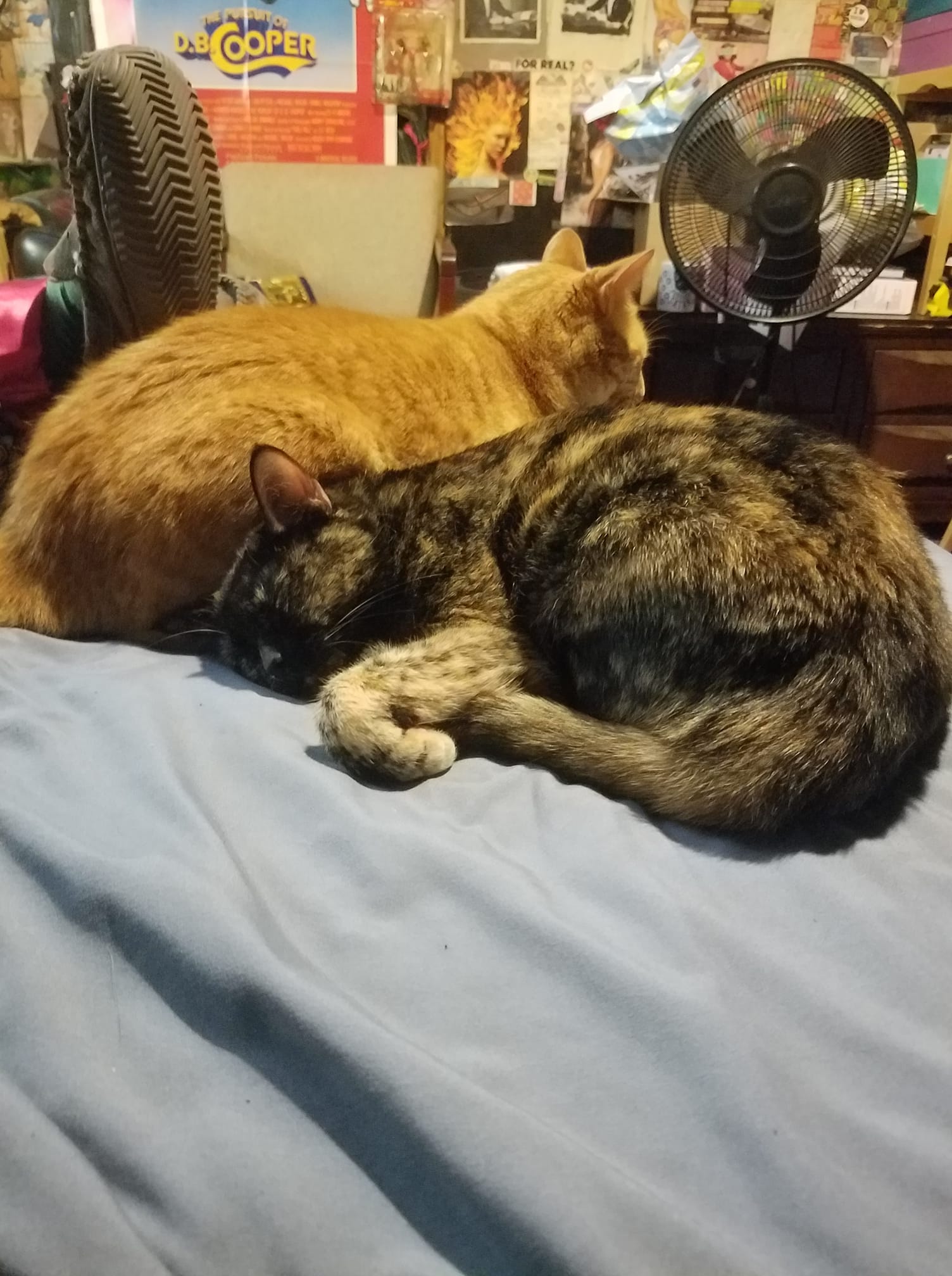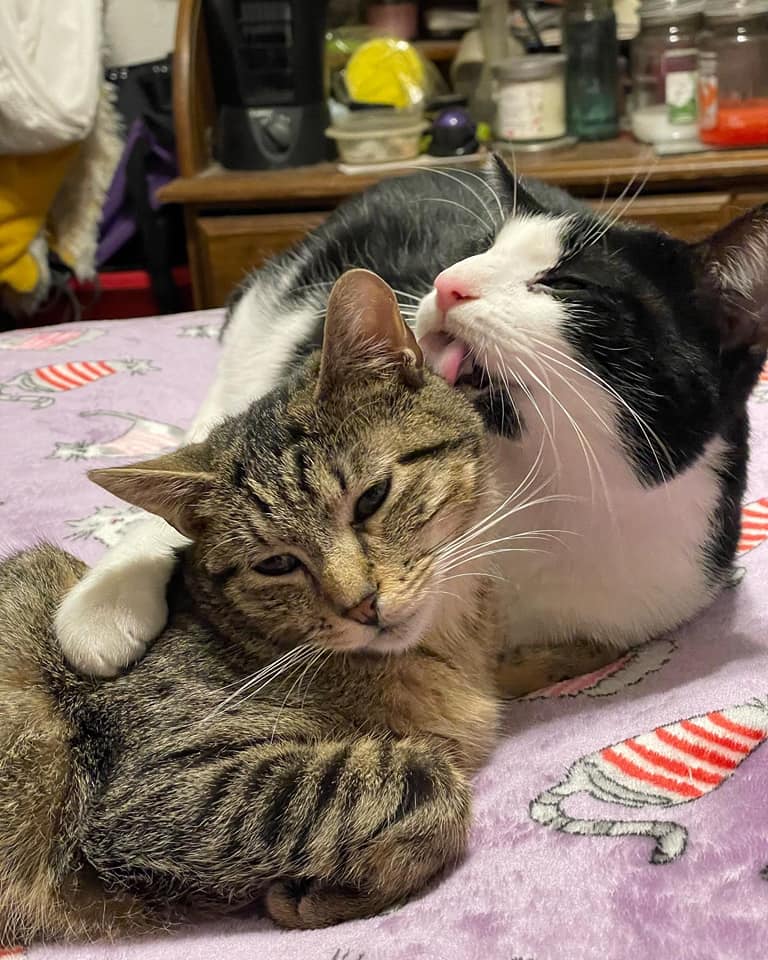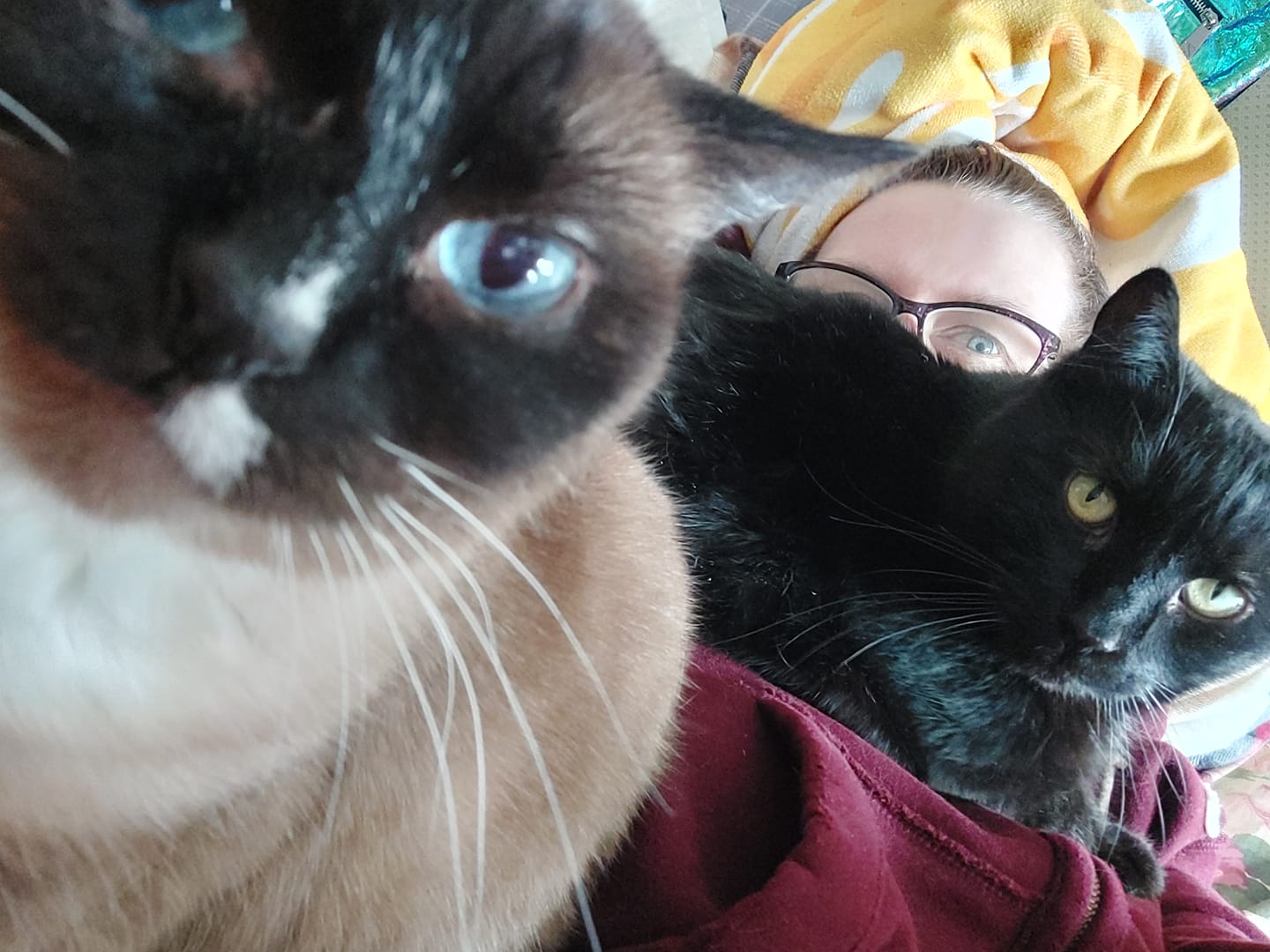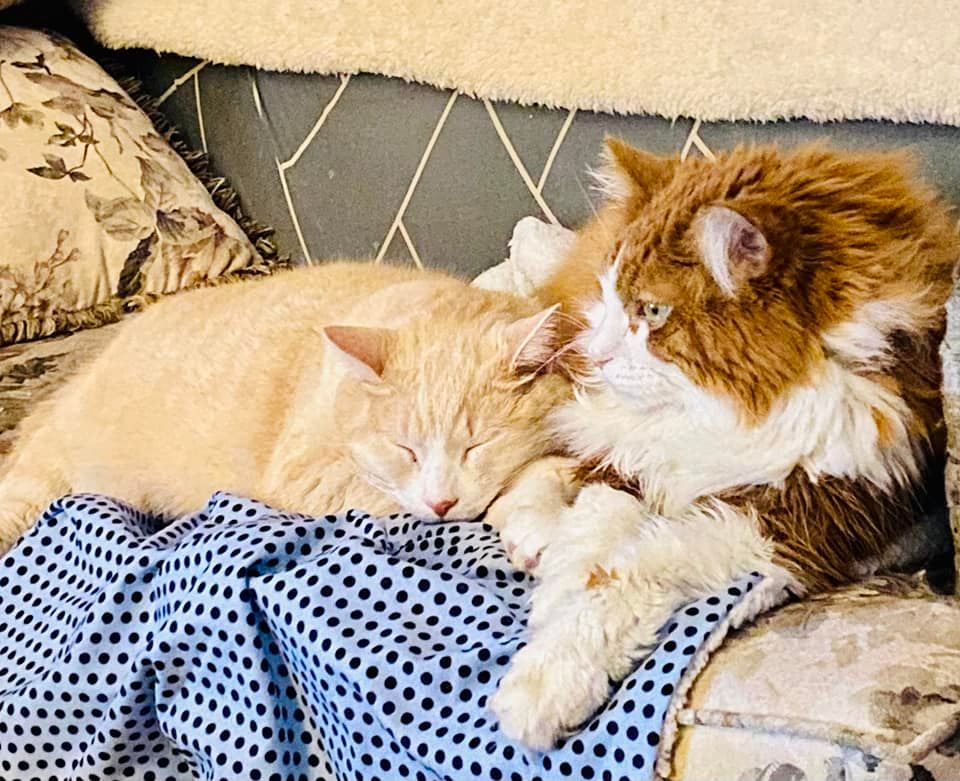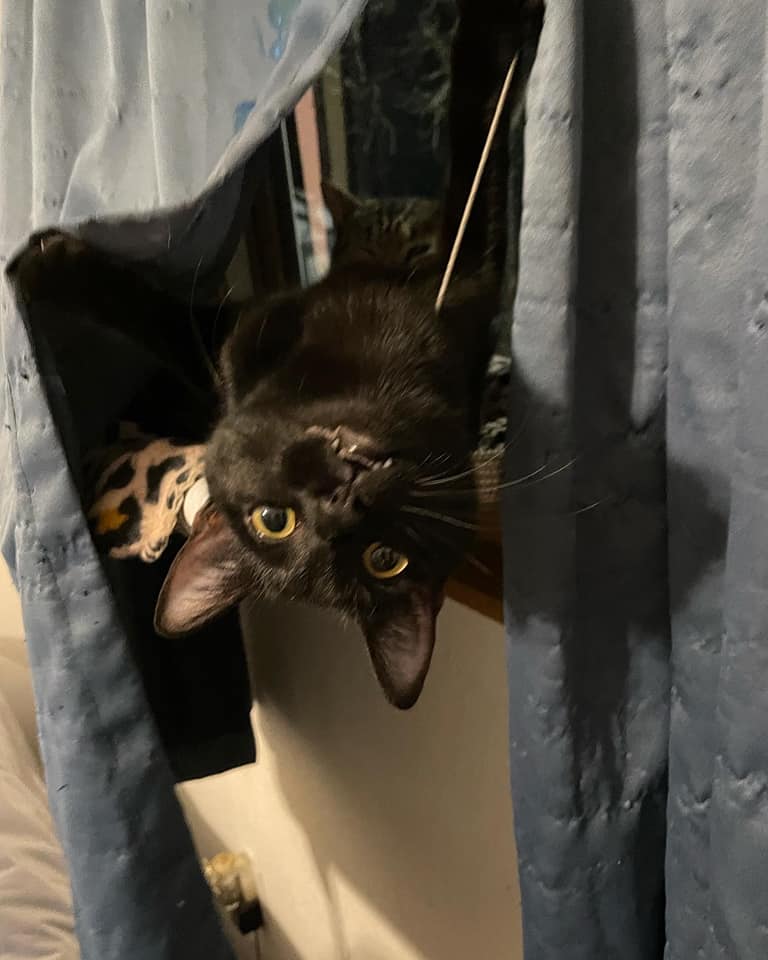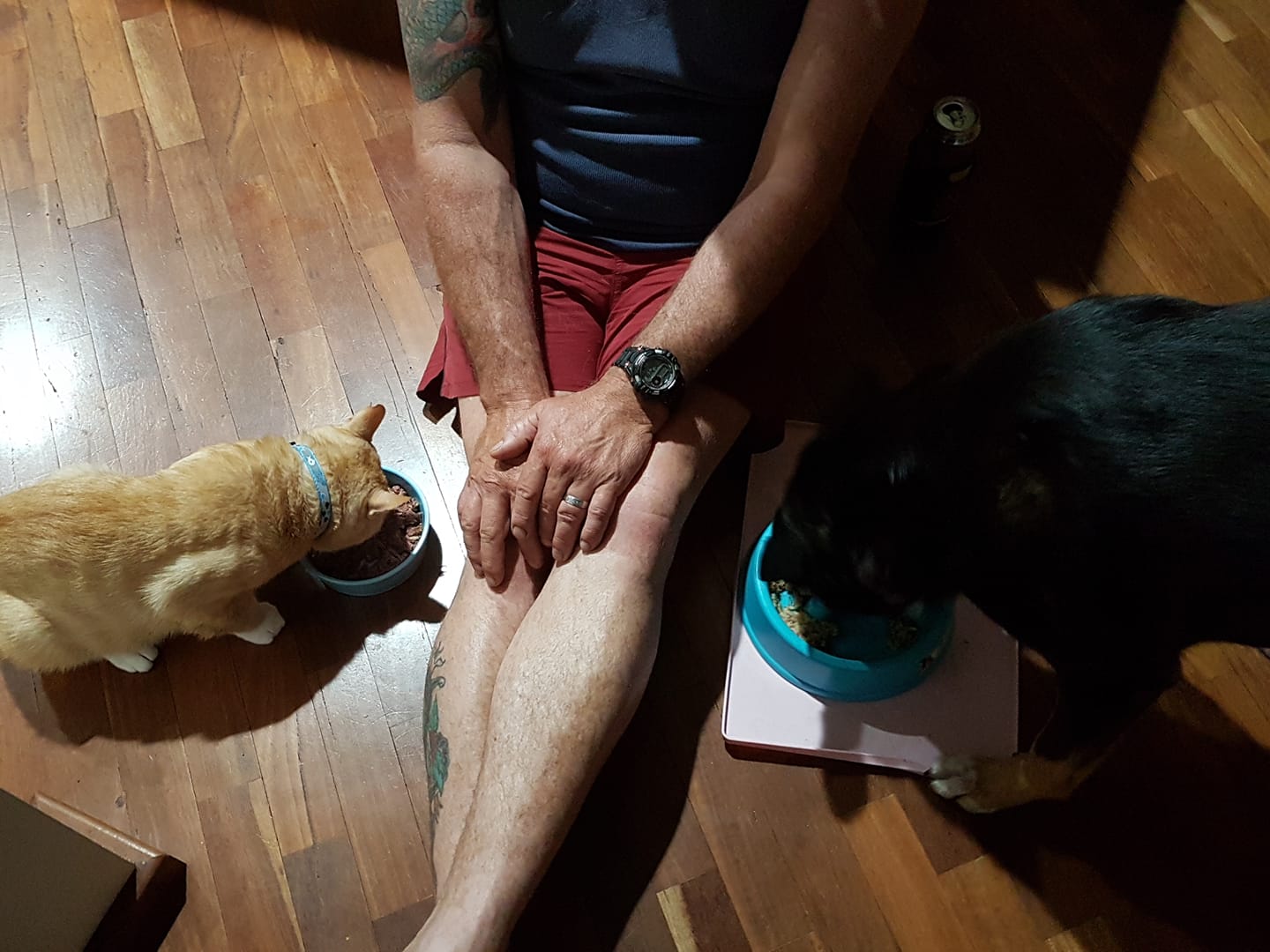Bringing Home a New Cat & Cat Reintroduction (Updated April 20, 2024)
Italicized sections are my (Rebecca, CCHS assistant manager and ABC Certified Cat Trainer) experiences with my own pets. I wanted to offer some first hand insight.
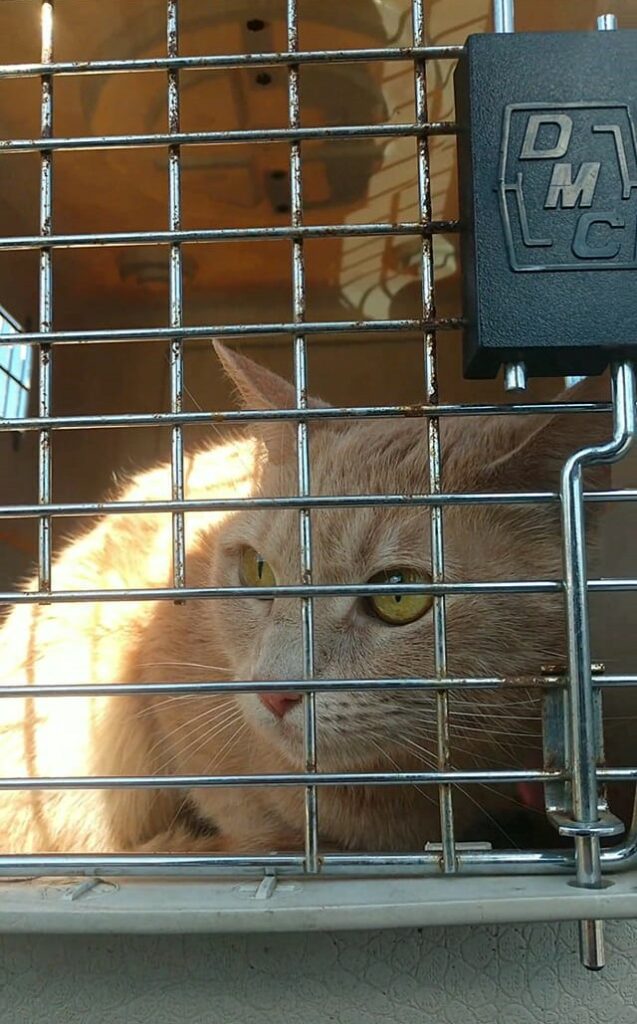 Taking home a new cat? That is so exciting! Here are my tips for making them as comfortable as possible and helping them settle in. Remember it will take your new cat some time to get used to the rules of the house, so don’t expect them to be perfectly well behaved right off the bat.
Taking home a new cat? That is so exciting! Here are my tips for making them as comfortable as possible and helping them settle in. Remember it will take your new cat some time to get used to the rules of the house, so don’t expect them to be perfectly well behaved right off the bat.
Most of these tips also work great for reintroducing cats who are not getting along. (See more details on why your cats might stop getting along below)
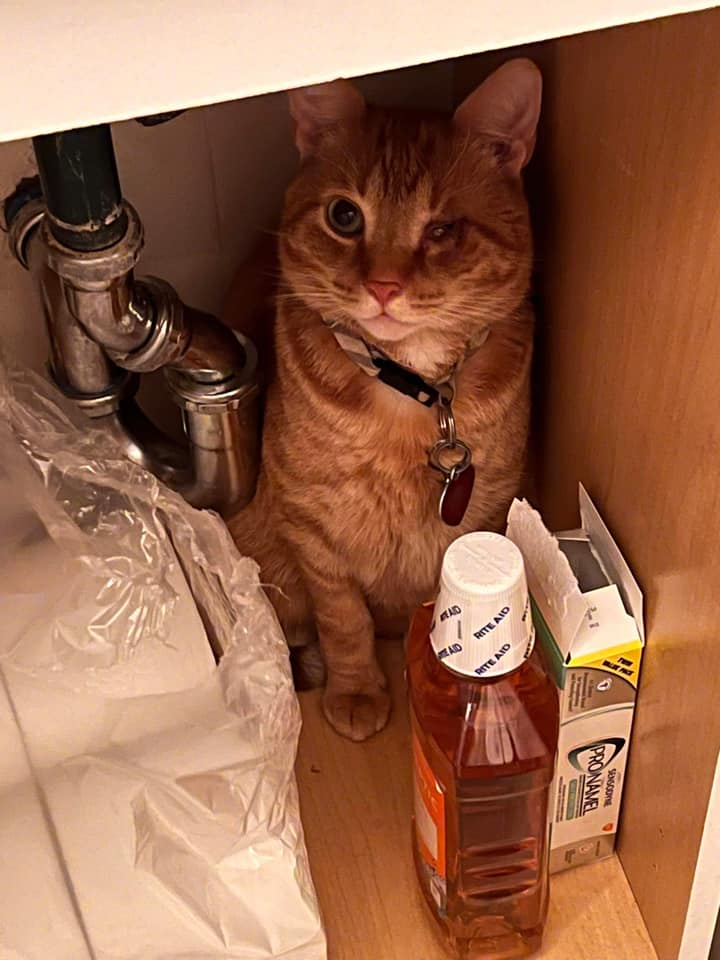
Child locks can be very handy to keep your cat out of places like under the sink. Small places like this can also serve as a cubby if you are okay with your cat hanging out under there!
Any time you are taking home a new cat or kitten (or moving), it is a good idea to keep them confined to one room or a smaller area at first to allow them to settle in. This is especially true if you have other pets and/or young kids or they are a very shy cat, but very social cats can benefit from this as well. It’s fine if this is a small room like a laundry room or bathroom, but even a bedroom would be fine. This room should be set up with a litter box, food, water, scratching post, toys, and a comfy hiding place. The comfy hiding place doesn’t have to be anything fancy. Their carrier, a cardboard box, or a cat cubby bed are great options. Make sure you put their hiding place somewhere where they are able to see the door, so they don’t get spooked if someone comes in the room.
Comfy hiding places
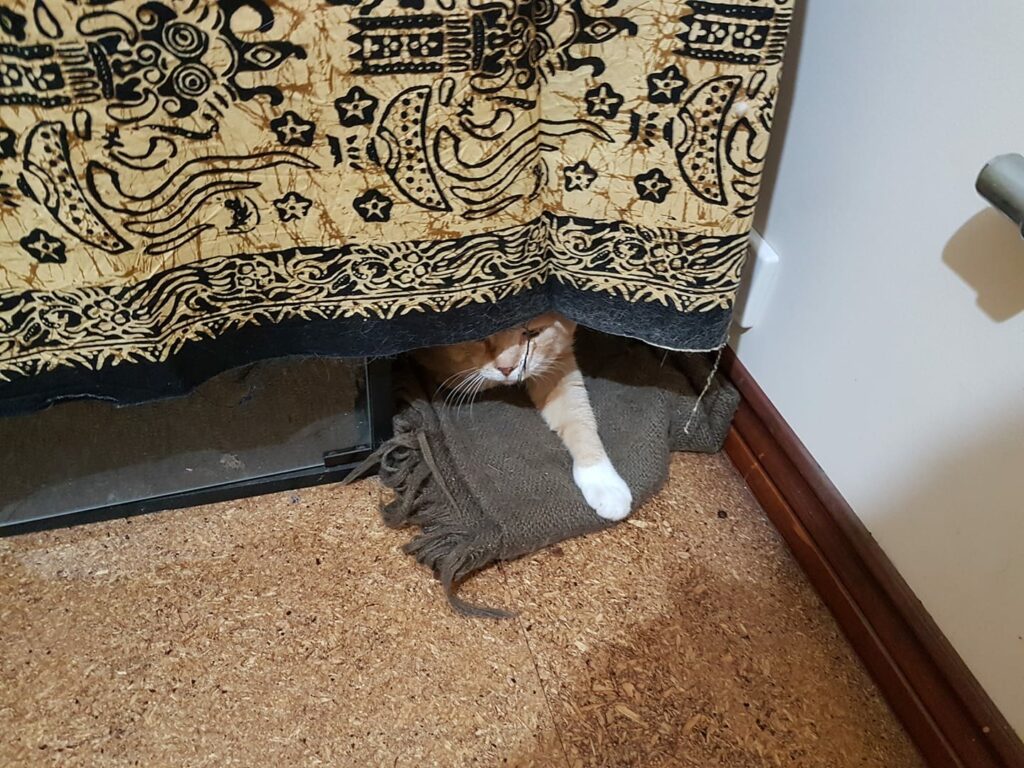
Hiding is totally normal at first
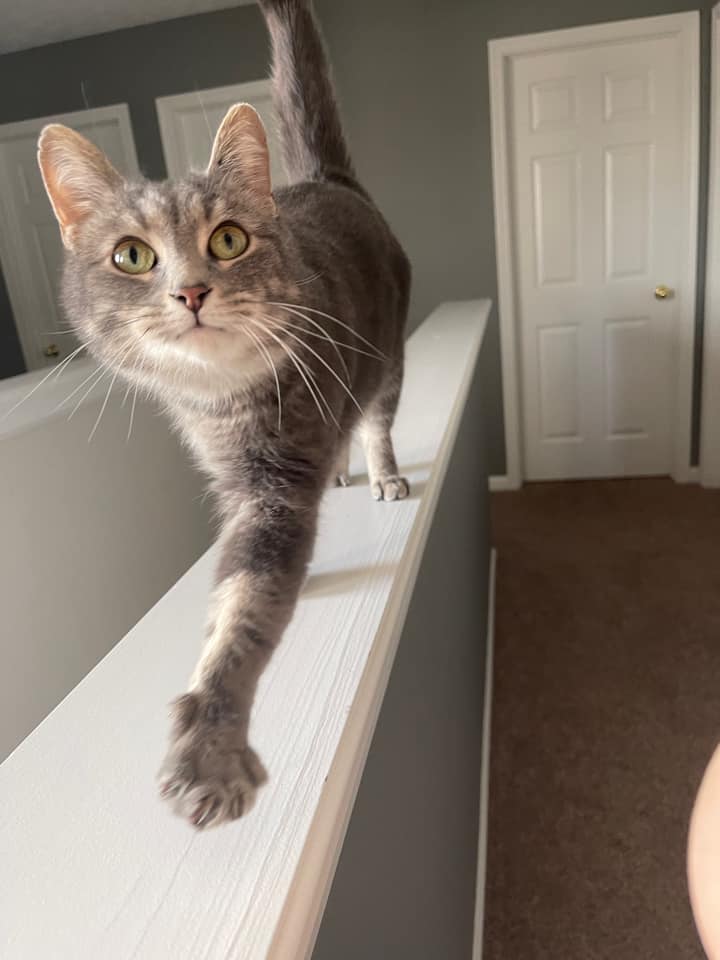
Confident cat
Depending on how nervous the cat is, it is a good idea to give them a few days to get used to being in a new place by keeping them in this room. If you don’t have other pets/kids, once the cat seems to be getting more confident (out of their hiding place, accepting pets, tail up) you can slowly start introducing them to the rest of the house. If you are able to keep them on one floor or shut off some rooms so they only have access to some of the house at first that is best. When the new cat is exploring for the first time it is a good idea to wait to introduce them to other pets and small kids, as they might be nervous checking things out the first couple times.
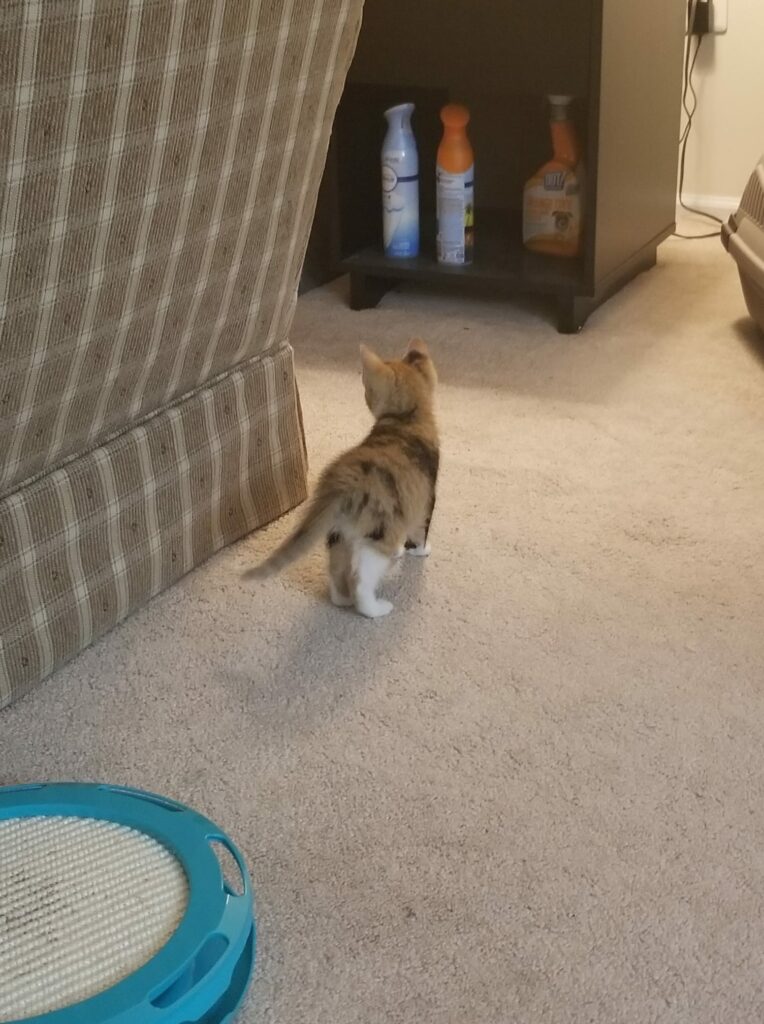
Hiding and not eating, drinking, or using the litter box the first couple days is not uncommon, so don’t panic. Keep in mind that your cat likely went from either a home or the streets to the shelter to now yet another new place. It is normal for them to be a bit freaked out for the first couple days. If they are not eating or coming out after the first couple days, you should get in touch with the shelter or your vet. A couple days is one thing, but if a cat goes for too long without eating they can develop serious medical issues.
Some cats want a lot of attention and comfort from you when they first go home. This is a good time to bond with them, but keep your regular schedule in mind as well. If you are home for the first couple days when you take them home that is great so you can keep an eye on them, but don’t set up your new cat to expect to get hugs and cuddles all day, every day if you work or aren’t around all the time.
Very helpful cats
Some cats (even the most affectionate cats) get freaked out when they first are brought home. Don’t be offended if your new feline friend is scared of you at first or wants nothing to do with you. Going to a new home is a big change. Giving them a day or two to get used to their new space is a good idea. Slowly spending more time with them can also help. Do not force yourself on the cat, just be around if they decide they want to come to you. NEVER drag your new cat out of a hiding place, unless it is medically necessary. A good way of allowing them to get used to you is to just sit in the room with them. Reading out loud can be beneficial or even just bringing a game or your computer in there and quietly doing something can help them realize you are not a threat.
Zuni and Mumbles
When I first took home Zuni (5 y/o male cat) and Mumbles (9 month old male cat) I confined one in the upstairs bathroom and one to the downstairs bathroom, each place having everything they needed. My super social boys wanted all of the attention right away, so I would alternate spending time with one then the other. A lot of studying was done spending time with my boys. Mumbles was really lonely at first, so I made the mistake of trying to put Zuni with him. Zuni and Mumbles were loose in the cat room together, so I thought they would be fine. My mistake. Zuni got really mad at the sight of Mumbles, so I immediately had to move him back to his room. Because of this level of sass I started alternating letting them out to check out the rest of the house one at a time. I then would switch which cat was in which bathroom, so they could get used to the other’s scent. I would also rub a cloth on Zuni’s face then Mumbles face then vice versa. Unfortunately I lived with a roommate at the time who did not understand the importance of SLOW introductions. Frequently when I wasn’t home they would let both cats out, which resulted in some fights, and I believe greatly slowed progress. I really think those fights extended how long it took for them to get along. Despite the slow progress, I continued to work with them. They both were comfortable with the house, so when I was home we kept letting them out of their rooms and letting them be together until they got grumpy then putting them back. We would give them treats and playtime when they were near each other and getting along. If they got grumpy, we calmly separated them. After about a month, we were finally to the point where they were able to be loose together full time. There would be occasional scuffles, but there was largely peace in the house.
Chi and the Boys
When I decided to adopt Chimalman (Chi) I very much thought about how she would fit with my other 2. Mumbles was a little older and now getting fat and lazy. I wanted a friend for him who would get him to play more. Zuni is now an older guy, and wasn’t too impressed with Mumbles when he did want to play. Chi was about 3, so she had plenty of energy, but she also wasn’t as wild as a kitten. She ended up being a perfect fit for my home. When I first brought her home, I set her carrier down and let Zuni sniff her. He hissed, which I expected, so I moved her to the bedroom I had set up for her. The house is set up with the living room and kitchen on the first floor, with stairs going straight up to the 2 bedrooms with a small landing. The room where I put Chi is where I kept most of the cats’ litter boxes, so I decided to move one to the first floor and another two to the top of the steps outside Chi’s room. I wanted them to have the box downstairs in case they didn’t want to be near her at first. I first fed her a little ways from the door and them about halfway down the steps. I slowly started moving their bowls closer and closer. Chi made herself right at home, and even right away didn’t seem too stressed. I spent plenty of time in this room giving her lots of love. After a couple days when I saw Zuni and Mumbles standing outside her door looking interested, I opened the door a crack. Naturally there was some hissing and crankiness, so I shut the door again and calmly shooed the boys away. I kept opening the door and letting them smell each other, and eventually they were okay with her coming out. Something else I did was pick her up and carry her downstairs and hold her in my lap. When I did this I would leave her door open, so they could check out the room and get used to her scent. She was perfectly content sitting on my lap while I played games or worked at my desk. I allowed the others to come up and smell her and if they were nice they could stick around. If they hissed they were gently escorted away. At first they would sometimes get really worked up, so I would bring her back to her room and give her some cuddles. After about 2 weeks, Chi was good the vast majority of the time. She occasionally would annoy her new brothers a little too much and need brief time out, but she and Mumbles became the best of friends. They still snuggle and play and just love each other. She and Zuni also get along great, and he will often go up to her and ask for kisses. We also love to all take naps together. Zuni lays by my feet, Mumbles lays beside me (though I could live without the occasional slapping when he wants pets), and Chi has to lay on me. She is the snuggliest little purr machine, and I am so glad I brought her home.
Introducing a new cat to your other cat(s)
Take it slow. Some cats are fine with each other immediately and do great, but it is risky to bring home the new cat and just open the carrier. Even cats that were at the shelter together might not immediately be friends (see Zuni and Mumbles). A really negative initial interaction can make the process of introducing a new cat a lot more difficult. As stated above, it is a good idea to keep the new cat confined to one room at least for the first couple days. When you want to allow your new cat to explore the house more, it is a good idea to have them switch places, with your new cat out and your cat(s) you’ve had in the room. This allows your other cat(s) to get used to the new cat’s smell and vice versa. Something else you can do to help them get used to each other’s scents is rub a rag or even a sock on your new cat’s face then your other cat(s) face then do the opposite starting with your other cat(s). Something else you can do while your new cat is confined in a smaller space is to start feeding your cats on either side of the door starting further away and inching closer if they do well. The best thing you can do to get your cats to get along is to help them create a positive association with one another. Feeding them on either side of the door is especially beneficial if your cat is food motivated. The goal is to eventually open the door and feed them next to each other Some other things you can do include playing near the door or giving them treats when they are near the door and not getting cranky. If they do get upset near the door, gently escort them away. Do NOT yell at them or do anything negative or they may associate that negative thing with the other cat rather than their rude behavior.
Introducing a new cat to your dog
Again, take it slow. The best way to set yourself up for success is to let your cat come to the dog at their own pace. Once the cat is starting to get more comfortable with the house, allow them to meet the dog. Bring the cat out to a more neutral territory (their room should be their safety zone to get away if they want to). Larger spaces like living rooms can be a good space for initial introductions. If the cat does well, you can allow them to spend some supervised time together. If the cat (or dog) gets worked up, calmly escort your cat back to their room, and don’t get discouraged. Cats are often dramatic when they first meet dogs, but with time even the grumpiest cats can usually get used to dogs. Another extremely important part of cat/dog introductions is always make sure the cat is able to get away if they want to. Forcing them to be near each other will not force them to like each other and can actually set you backwards.
My Boys Meet the Dog
We took home a goofy, high energy shepherd mix, already having 2 cats at home. Not exactly the same process as bringing home cats to a home with dogs but pretty close. He lived with cats before, but we still crated him when we were not home to be on the safe side. At first our kitten was a bit scared of him, but within a few days he was chasing the dog (yes the kitten was chasing the dog) around the house. They were pretty quick buddies and would play. My 5 year old cat (Zuni) was less than impressed. He took one look at the dog and took off upstairs. We kept the dog downstairs, so Zuni could have his safe space upstairs. Slowly Zuni started to come down more, especially when the dog was in the crate. He would sniff the dog and slowly started to get more comfortable with him. Something that really helped was having some safe places downstairs where Zuni could go and see the dog, but the dog couldn’t get to him. He would sometimes bat at the dog from his cubby, but he did this less and less as time went by. By allowing Zuni to get to know the dog on his own terms, eventually they were fine together, and Zuni would come downstairs as he pleased.
If your dog has never been around cats, ALWAYS keep them separated, at least at first to be sure the dog will not hurt your cat. The sweetest dogs with people sometimes have what is called prey drive. You cannot train instinct out of them, so please be very cautious.
Introducing your cat to smaller pets
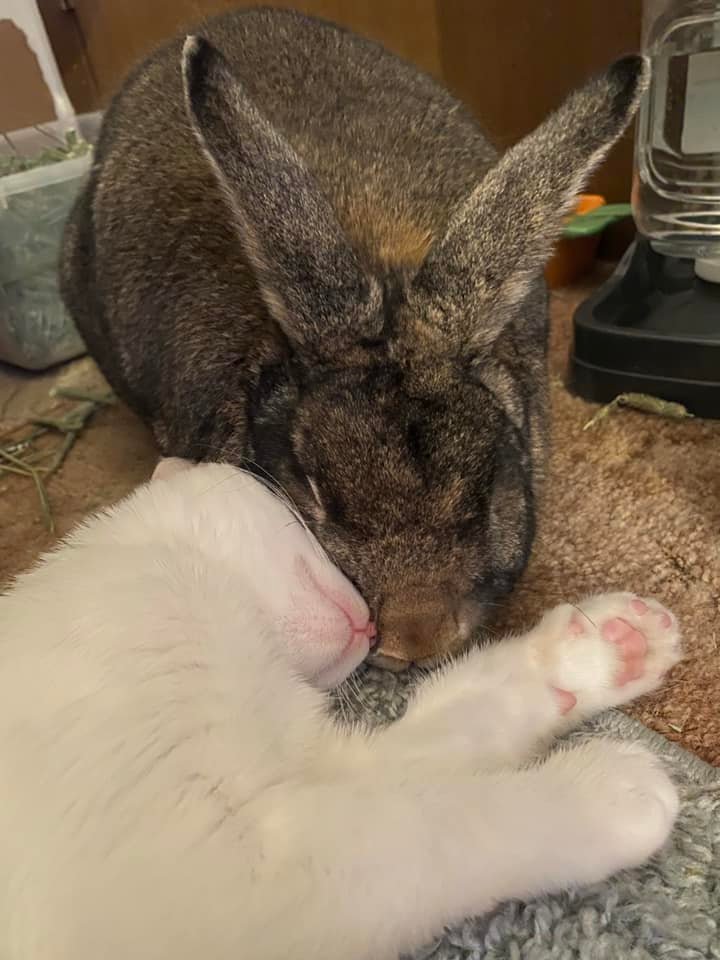
Use caution! Some cats get along great with small pets, but cats do tend to have prey drive, so be extremely careful if your cat is near smaller pets like mice, gerbils, hamsters, etc. Some cats, especially when raised with them can get along with rabbits or some small animals, but always be careful, and make sure all time they have together is supervised at first. With hamsters and other small pets I would never allow them to be near each other unsupervised, but I have heard of some people having luck getting their cat and rabbit to get along.
Introducing a new cat to your young kid(s)
As stated above, it is a good idea to give your cat a couple days to settle in before meeting any young kids. Especially very young kids or kids who have never been around cats may need some coaching on how to properly behave around a cat (no tail pulling, grabbing, etc.) It’s a good idea to take the cat out of their safe room and meet in a more neutral space, like a living room. If the cat is scared, allow them to go back to their room or hide, and don’t get discouraged. It may take them some time to become comfortable with small children, and the best thing you can do is let them take their time getting used to them. The last thing we want to see is a child getting bit or scratched by a nervous new cat. This process may take some time, but it is always so good to see kids grow up learning to respect animals.
Cat REintroduction
Why do my cats suddenly not get along? Regardless of the cause typically reintroduction (the same process listed above that you would do with a new cat) helps.
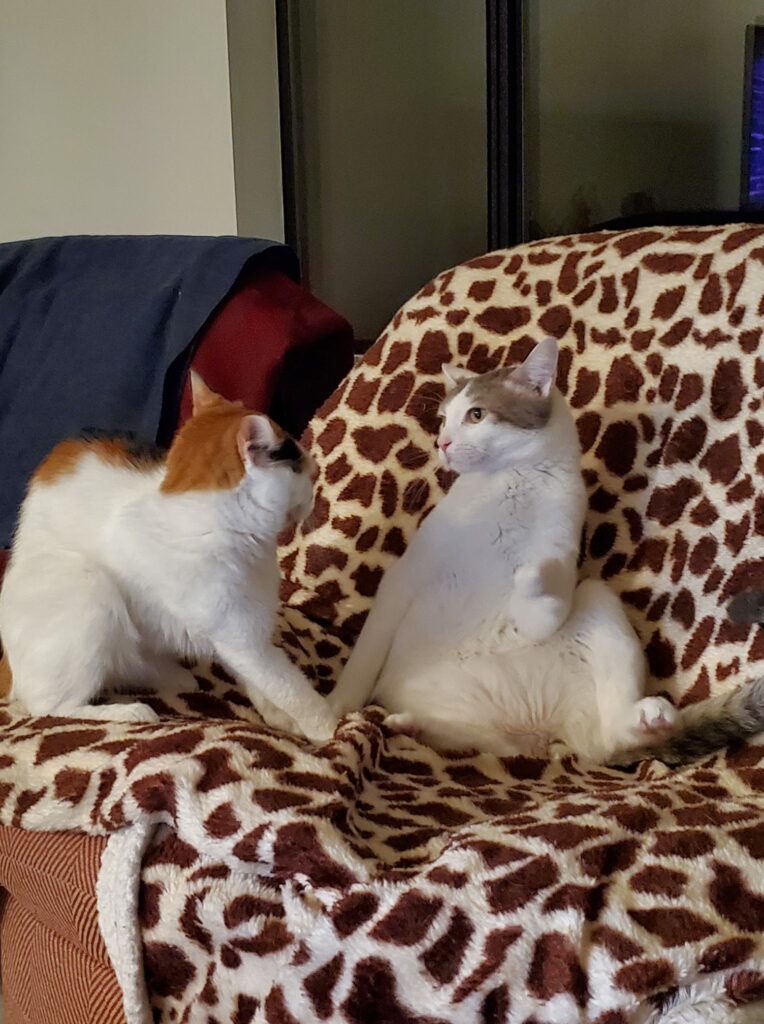 Cats are interesting and sometimes strange creatures. Cats who have grown up together or known each other for years occasionally stop getting along for some reason. First thing to rule out is always a medical explanation. If your cat is in pain, they may lash out at you or other pets. Cats’ instinct is to hide pain, so you may not even know something is going on until their behavior changes. Especially if crankiness is accompanied by not wanting to use their litter box (especially to pee) you could be dealing with a urinary issue like a urinary tract infection. Older animals (especially declawed cats) sometimes develop arthritis, and the pain can make them get crabby with other animals and even people. It is important to always rule out a medical explanation first. Even once the medical issue is resolved you may need to reintroduce your cats if they are still not getting along. They may associate the other cat with the pain of whatever medical issue is going on, so you need to reform that positive association.
Cats are interesting and sometimes strange creatures. Cats who have grown up together or known each other for years occasionally stop getting along for some reason. First thing to rule out is always a medical explanation. If your cat is in pain, they may lash out at you or other pets. Cats’ instinct is to hide pain, so you may not even know something is going on until their behavior changes. Especially if crankiness is accompanied by not wanting to use their litter box (especially to pee) you could be dealing with a urinary issue like a urinary tract infection. Older animals (especially declawed cats) sometimes develop arthritis, and the pain can make them get crabby with other animals and even people. It is important to always rule out a medical explanation first. Even once the medical issue is resolved you may need to reintroduce your cats if they are still not getting along. They may associate the other cat with the pain of whatever medical issue is going on, so you need to reform that positive association.
Something else that can cause them to stop getting along is a very loud noise or something else that scares them quite bad that they associate with the other cat rather than the actual source of the thing that scared them.
Knuckles and the cranky neighbors
I lived in a horrible house with multiple apartments and absolutely no soundproofing. The neighbor downstairs would get mad when I got up early to go to work and would beat on their ceiling/my floor so hard that my fridge would move. I had just adopted a new cat before this started happening and when I was introducing him to my other 2, the neighbor would make the floor shake and they would associate that scary noise with each other, thus causing them to be fearful of each other and even lash out and fight. It was far from an ideal way to first introduce them, and thankfully after we moved they got along a lot better.
There might be wildlife or a not fixed cat outside that is causing your cat to feel insecure. This is often what causes them to start spraying, even if they are fixed. It can also lead to fighting between your indoor cats, even if they never go outside and actually meet the culprit. If it’s wildlife, you may want to remove what is attracting them e.g. put your trash in a raccoon proof trash can, block off that spot under your porch that the skunk is hiding under. If it is a not fixed stray cat, you may want to try to catch them and bring them to your local animal shelter. If that’s CCHS, just get in touch with us and we will gladly take in strays.
Another factor that could cause your cats to stop getting along is a big change in the household e.g. moving, new baby, new pet. Some cats are more sensitive to change than others.
There are some other factors that are more rare that may be causing your cats to not get along. One of our staff members ultimately had to separate her 2 cats after bringing one in to get groomed. When she came back she smelled different and her other cat didn’t recognize her despite growing up with her. This is quite uncommon however. I also have a cat who sometimes gets very rude with my other cats when they come back from the vet because they smell like the dreaded vet. He typically gets over it in a few hours though.
Cats are strange and sometimes complicated creatures. If you have any questions or problems with your cat(s) feel free to email Rebecca at asstmanager@cchumanesociety.com. Bear in mind I am NOT a veterinarian, and if there is anything medical that may be going on I will direct you to talk to a veterinarian. I have however worked at CCHS for 10+ years, and I have a lot of experience with a variety of different cat behavior problems.
Remember if you adopt from CCHS, you are contractually obligated to bring the animal back to us if it doesn’t work out. DO NOT REHOME THE ANIMAL YOURSELF! We hope everyone will give their new pet plenty of time to get used to a new home, but sometimes things just don’t work out, and we understand if you have to bring them back. We are happy to assist with ideas on how to improve the situation, but if ultimately you decide they are not a good fit, just get in touch with us, and we will set up a time for you to bring them back.
Author: Rebecca, assistant manager
Big thank you to the Gorgeous George Fan Club on Facebook for providing me with some great (and adorable) photos!
